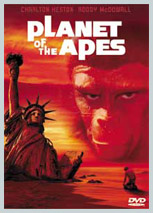|
Review added January 13, 2005.
Planet of the Apes
:: DVD Review |
|
.
. |
|
|
|
| |
 |
|
|
Studio:
20th Century Fox |
 |
>> Review
Equipment |
|
Video:
2.35:1 (Enhanced for 16:9) |
 |
Length:
107
Minutes |
|
Audio:
Dolby Digital 5.1 (384kbps) En |
 |
Subtitles: En/Por/Sv/No/Fin/Dan/ |
|
Video Format:
PAL |
 |
 Pol/Heb/Cz/Hu/Ice Pol/Heb/Cz/Hu/Ice |
|
Layer Change:
45:25 |
|
Disc Format:
RSDL
DVD-9 |
|
Average Bit-Rate (A+V):
X.XXMbps |
 |
Disc Capacity Utilised:
X.XXGB |
| |
 |
Region Coding:
4 |
| |
|
|
|
|
|
|
.
. |
|
:: The Film
:: |
|
>> Skip to
Audio/Video Details
Like '2001', Planet of the Apes is
an extraordinarily influential film, marking a turning point
in the presentation of science fiction on film; transforming
it from cinematic black sheep into a respectable, and
respected, film genre. Virtually every science fiction film
made in the last thirty years owes a huge debt to both.
Planet of the Apes was as much political statement as
science fiction film, with the social segregation and
prejudice of the ape culture on film aping (sorry!) that of
American society.
The film's undercurrent of
potential catastrophe also paralleled the very real threat
of nuclear annihilation present in late 1960s America. For
those uninterested in political statements, the film also
featured an intelligent story with a real sting in the tail
from Pierre Boule, revolutionary special effects makeup, and
a closing shot that virtually guaranteed its place in
cinematic history.
|
 |
If you haven't seen Planet of the Apes, do yourself a favour
and pick up a copy today. You won't regret it. As a side
note, whoever designed this DVD's cover deserves a dozen
lashes with a wet noodle. Never before have I seen such an
obvious spoiler on a DVD's cover.
|
|
| ::
Video
:: |
.
. |

|
This anamorphically-enhanced 2.35:1 transfer comes to us
from 20th Century Fox who, after a shaky start, have
started producing exceptional discs with pleasing
regularity. This film is now 33 years old, but you
certainly couldn't guess its age based on the quality of
this transfer, which betters many much more recent
efforts. The print used for the transfer is very clean
indeed although, due to the film's age, film artefacts in
the form of hairs and blemishes are inevitable.
Considering the age of the film, however, the lack of
artefacts is quite remarkable, and large sections of the
film pass without any artefacts whatsoever. Most
impressive.
The transfer is generally smooth, clear and
sharp, with significant fine detail evident on screen. The
only obvious exceptions being at 28:08, where the transfer
momentarily but dramatically loses resolution, and during
a telecine pullback in the film's final scene. Grain is
sporadically visible, most noticeably during several of
the film's many wide shots of desert and blue sky, but is
a problem with the print source not the transfer itself
and a minor one at that. Blacks are generally excellent,
remaining deep and stable with no digital noise or grain
and there is absolutely no edge enhancement to be seen.
Aliasing is present but minor, the worst of
which can be seen at 34:02, and minor shimmer is
occasionally present but, like the aliasing, minor and
never distracting. Colours are superbly rendered: the
film's many browns, greens and earth-tones are fully
saturated and accurate to the film's theatrical
presentation, as are skin tones. This presentation is
easily the best I have seen this film look.
|
 |
|
.
. |
| :: Audio
:: |
.
. |
|

|
Due to the film's age, this remastered Dolby Digital 5.1
soundtrack was never going to knock anyone's socks off, but
the presentation was still a pleasant surprise. Dialogue is
always clear and easy to understand, with the vast majority
looped in the recording studio. This looped dialogue sounds
slightly compressed with rolled off high frequencies, but
remains perfectly legible.
The film's unusual Jerry Goldsmith
score is of surprisingly high overall fidelity, and has been
spread broadly across the front soundstage. Directional cues
are scattered throughout the film, but are not as overt as
those in more recent soundtracks, tending to be slightly left
or right of centre. The soundtrack's dynamic range was quite
good, as was its bass content; although neither are
particularly impressive by modern standards.
The LFE channel is essentially
silent, its only detectable use being at the beginning of the
film, and there is little activity in the surround channels,
their only regular use being to support the score. There were
no split surround effects. The overall soundstage is very much
front hemisphere oriented, so don't expect an enveloping audio
experience. This is a nice soundtrack that complements the
film well, but definitely shows its age.
|
 |
|
.
. |
|
|